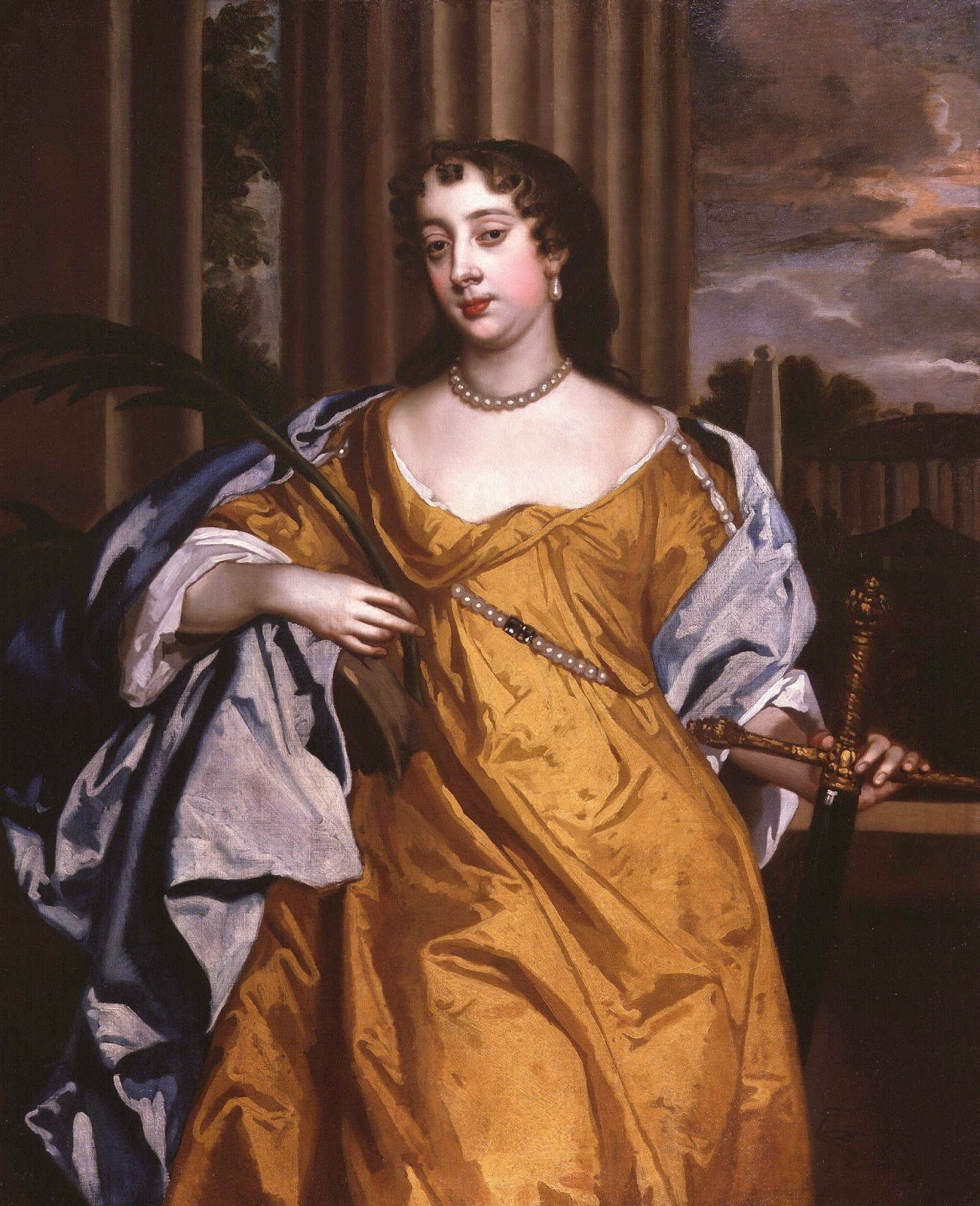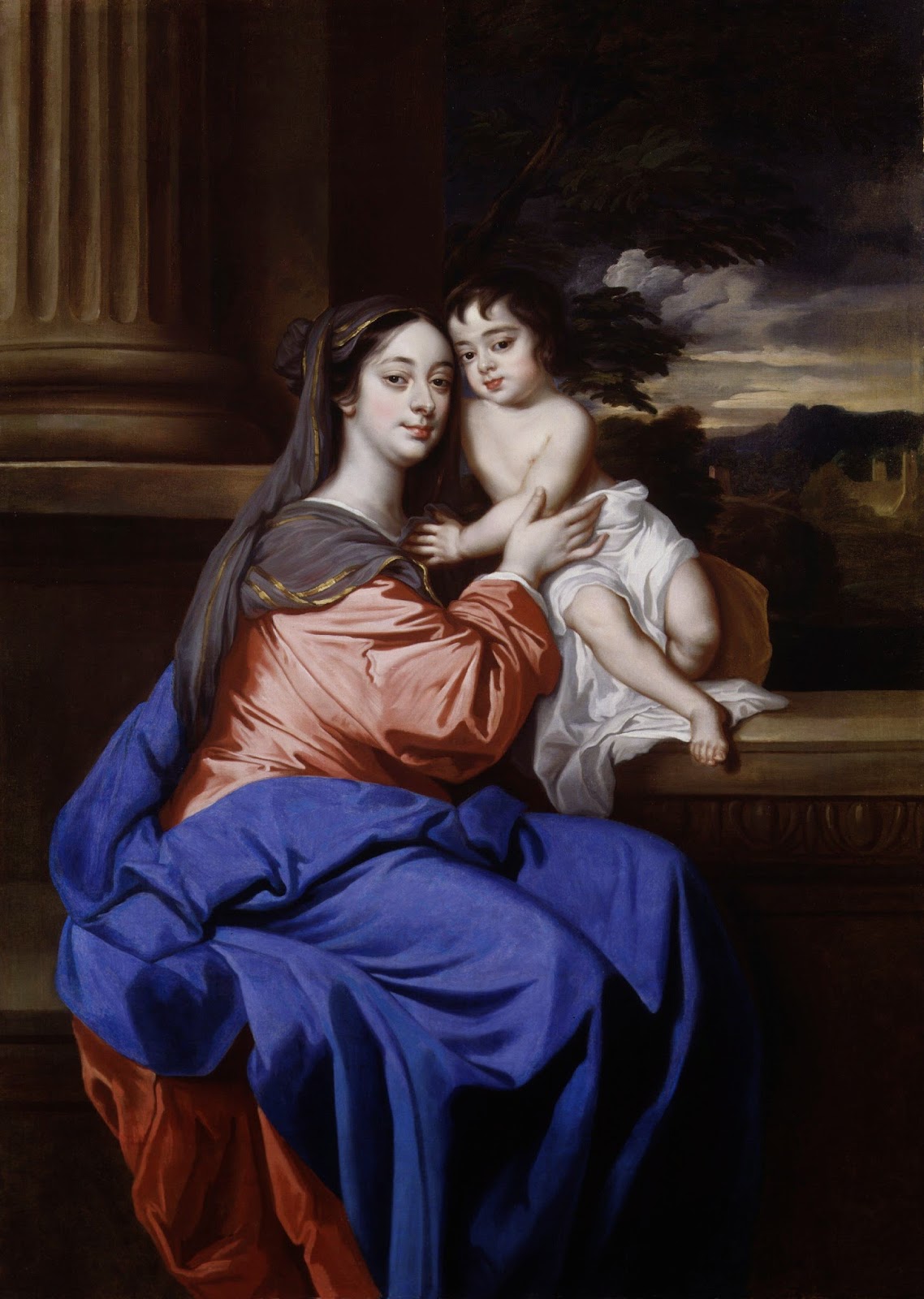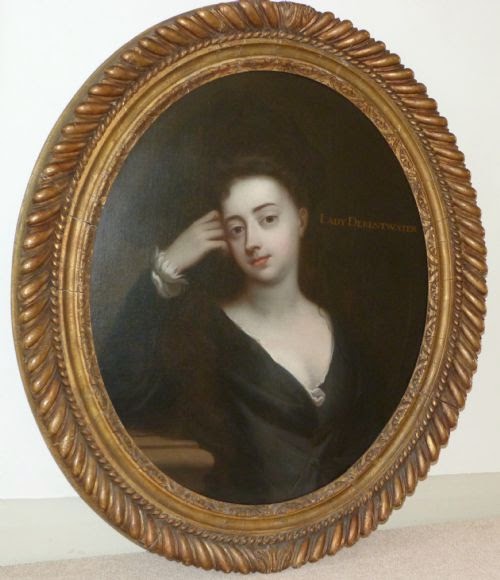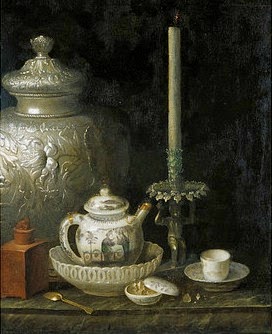![]() |
Charles II presented with a pineapple, supposedly the first grown in England in 1675, outside Ham House.
|
It can be said that Charles II lived a life in pursuit of pleasure. He was known as the Merry Monarch and he enjoyed the high life. He is most famous perhaps for his large number of mistresses and illegitimate children. From his mid-teens until his death, there were plenty of women in his life, but the king was not as debauched as some of his enemies would have liked you to believe.
Yes, Charles was married (though not when some of his illegitimate children were born), but he wasn't the first king to have mistresses, and he treated his wife well in comparison to some of his ancestors! But the king didn't have lots of mistresses all at once, they were spread out across his life, and, perhaps with one or two exceptions, he pretty much stuck with one mistress at a time. He also accepted parentage of many of his illegitimate children.
Some of Charles' mistresses were richly rewarded for their services with pensions and other incomes awarded to them, along with homes and expensive gifts. They were also in some cases given noble titles, as were some of their children fathered by the king.
Below is a roughly chronological list of the most well known of Charles' mistresses, and some of the children fathered by Charles.
Lucy Walter
Charles met Lucy Walter in 1648, whilst he was still living in exile. I suppose she was more of a lover than a mistress. In 1649 Lucy gave birth to a son, Charles' first acknowledged illegitimate child. The child was named James.
The relationship was not to last long. As Lucy fell rapidly into a life of dissipation, she was alleged to have aborted 2 further children, and was also charged with murdering a maid, although the charges were later dropped. Charles distanced himself from Lucy, but made attempts to 'rescue' his son, practically kidnapping him, but his attempts were unsuccessful and it wasn't until 1658 when Lucy was dying of syphilis in Paris that she agreed to hand over care of her son to his grandmother, Henrietta Maria, wife of Charles I and mother of Charles II.
![]() |
| Duke of Monmouth |
As an illegitimate child, James could not be heir to the throne. He was given the title of Duke of Monmouth. You will hear more of the Duke of Monmouth in later posts when we look at the reign of Charles' younger brother, James II.
Elizabeth Killigrew
Married to Francis Boyle, son of Lord Cork; a wealthy Irish landowner, Elizabeth Killigrew followed the exiled queen Henrietta Maria to Europe and became the queen's Maid of Honour, as part of the court she would have met Charles often.
Elizabeth and charles had a daughter, Charlotte Jemima Henrietta Maria Fitzroy in 1650. I can't ind any pictures of Elizabeth, but I did find this sweet portrait of her daughter Charlotte.
Charlotte married twice, and it was through her second marriage, to William Paston, that she eventually became lady Yarmouth.
Catherine Pegge
Another affair conducted whilst in exile from England was that of Catherine Pegge. Her father was a Royalist supporter, and after he was captured by the Parliamentarians, he was forced into exile with his family.
Their liaison resulted in the birth of two children, a daughter Catherine Fitzcharles in 1657 who died and Charles Fitzcharles in 1658. Charles Fitzcharles was given the nickname Don Carlo, because of his Spanish looks. Charles became the 1st Earl of Plymouth.
![]() |
| Charles, First Earl of Plymouth |
Winifred Wells
Winifred Wells was a courtier, the Maid of Honour to Charles' wife Catherine of Braganza. Samuel Pepys makes reference to Winifred as the King's mistress in his diaries. Pepys also wrote in his diary that Winifred had 'dropped a child' (given birth) during a ball held at court in December 1662.
From what I can make out, this is one child that Charles does not acknowledge as his own.
Barbara Palmer
Barbara Palmer is said to have met Charles whilst he was still in exile. She was married to Roger Palmer, a Catholic Royalist, who became a politician in 1660, and who was said to be a gloomy, depressed figure in the presence of his wife. It was in 1660 also that Barbara became Charles' mistress. Roger's father had warned his son that Barbara would make Roger one of the most miserable men in the world, when he discovered their plans to marry. In part he was probably right. Made 1st Earl of Castlemaine in recognition of his services to the King in 1661, he separated from his wife in 1662, though they never divorced.
![]() |
| Roger Palmer |
Barbara gave birth to a girl in 1661, and claimed Charles as the father. Her daughter was named Anne, who later became the Countess of Sussex. A son was born the following year, Charles was later to become Lord Limerick, the Earl of Southampton - later the Duke of Southampton, and 2nd Duke of Cleveland.
Barbara was generally known in court as Lady Castlemaine. in the early years she had a great deal of influence on the King within his court. She was known to have a quick temper, which the king gave in to. Naturally, Queen Catherine (of Braganza) was not happy about Lady Castlemaine's power and she and the Queen were known to dislike one another.
When Barbara was appointed Lady of the Bedchamber, Queen Catherine opposed it, but, unlike those of Lady Castlemaine, her tantrums and threats were ignored. The Queen had the backing of Edward Hyde, 1st Earl of Clarendon; the King's Chief Advisor. Clarendon, related by marriage to Lady Castlemaine, felt embarrassed by her role as mistress and her constant presence at court. He bitterly resented her, and tried what he could to remove her. His plans eventually backfired, and it was he that was dismissed in 1667. In the end Queen Catherine found that good grace, tact and restraint had a better effect on the King, and their marriage settled down amicably
![]()
For reasons that remain unclear, Lady Castlemaine converted to Catholicism in 1663. This was an unusual decision in a country still hostile to the religion. Perhaps she wished to appease her estranged husband, or maybe she felt it would curry favour with King Charles; However his response to the news was that he was interested in ladies' bodies, not in their souls.
By the end of the 1660s Charles affections for Lady Castlemaine were on the wane. He had fallen for the 'witty, pretty Nelly'; a young actress called Nell Gwynn, probably the most well known of Charles' mistresses. Barbara had taken several other lovers, including John Churchill, Duke of Marlborough. In 1670 Charles made Barbara First Duchess of Cleveland, Countess of Southampton and Baroness Nonsuch (it was Barbara who had Henry VIII's Nonsuch palace demolished and sold off the pieces). Generous perhaps, but seen by most historians as a form of Golden Handshake. Perhaps to appease her fiery temper as she was cast from Charles' affections.
Barbara's fate was sealed when the 1672/3 Test Act was passed, banning Roman Catholics from holding office, she lost her position as Lady of the Bedchamber and was advised by the King to live quietly and to cause no scandal.
![]() |
| Barbara, Lady Castlemaine with her son Charles Fitzroy |
Of her six children, Charles acknowledge five as his own.
Anne Fitzroy (Leonard), Countess of Sussex
Charles Fitzroy, 2nd Duke of Cleveland
Henry Fitzroy, 1st Duke of Grafton
Charlotte Fitzroy (Lee), Countess of Lichfield
George Fitzroy, 1st Duke of Northumberland
Barbara Fitzroy. (probably the daughter of John Churchill)
![]() |
| Anne Fitzroy as a child |
![]() |
| Charlotte Fitzroy as a child... |
![]() |
| And as an adult |
Nell Gwynn
The famous diarist, Samuel Pepys took an interest in most of the King's mistresses, and recorded details about them within his diaries. He described Eleanor Gwynn as 'Pretty, witty Nell.
Nell is perhaps the most famous of Charles' mistresses, the 'rags to riches' story has popular appeal. Not much is known about Nell's origins, She is described as being born either in London, Oxford or Hereford, of Welsh decent. Her mother ran a bawdy house, otherwise known as a brothel, though Nell is recorded as claiming never to have been a prostitute there, only serving visitors with strong drink.
It was through a friend of her mother's that Nell obtained a job selling oranges to audiences within the theatre on Drury Lane, the King's Playhouse. Young attractive girls were used to sell the oranges and other fruits and confectionary to the gentlemen and ladies in the theatre, some would certainly be no stranger to prostitution, but that doesn't necessarily mean that they sold favours as well as oranges within the theatre itself.
Nell's looks, her quick wit and clear voice attracted the attentions of Thomas Killigrew, the theatre's owner. She soon found herself on the stage itself as an actress. Her first recorded appearance on the stage was in 1665, playing Cydaria in a drama by John Dryden titled The Indian Emperour.
Nell was not taken by the part, she didn't like the serious parts and hated serious plays, Samuel Pepys, who saw a later performance of the play with Nell in the same part thought she was badly miscast.
Her famous wit meant she was more comfortable playing roles in the new Restoration Comedies of the day and it was in these roles that she grew to be a successful actress.
![]() |
| Nell Gwynn stuffing sausages. Yes, this was as suggestive at the time as it might be considered now!! |
In 1667, George Villiers, second Duke of Buckingham, attempted to introduce the King to Nell, but the plan failed, perhaps because Nell had sought a fee of £500 a year to be kept by the King. Buckingham set the Charles up with another actress instead, Moll Davis (I'll tell a you a little about Moll Davis next!).
The king's affair with Moll Davis didn't last long, and by 1668 Nell Gwynn was well known to be the King's latest mistress. In April 1668 the King and his brother the Duke of York attended a play called She wou'd if She Cou'd, the King saw little of the play, instead he flirted with Nell, who was in the next box (probably not by chance!). Charles is said t have invited Nell out to supper after the play, but after the supper, the King found that he and his brother had no money. It was Nell Gwynn who ended up paying the bill, and is said to have exclaimed in good humour, "Od's fish! but this is the poorest company I ever was in!"
In 1670 Nell gave birth to a son, another on the growing list of Charles' illegitimate children. Charles Beauclerk (the K is silent) and to another son in 1671, James Beauclerk. Nell was moved into a house on Pall Mall, but was unhappy to be merely the lessee, not the owner of the property, and demanded the house be signed over to her. She did eventually get her own way in 1676.
It seems that Nell was also determined to have her children raised as gentlemen. Sadly, James died in 1681 whilst being educated in Paris. Her elder son Charles was granted the Earldom of Burford in 1676 (at the same time his younger brother was given the title Lord Beauclerk). Quite how he came to be granted this title is subject to speculation, some say that on a visit to his son by the King, Nell called out something along the lines of, "Come here you little bastard and say hello to your father!" The King is said to have protested at the way Nell called her son, to which she replied. "but Your Majesty has given me no other name by which to call him!" The other story is that Nell took her son and held him outside a window, threatening to drop the child unless he was granted a peerage, to which the King responded by saying "God save the Earl of Burford!". in 1684 Charles granted his son the title of Duke of St Albans.
![]() |
| Charles, Earl of Burford, Duke of St Albans |
On his deathbed in 1685 Charles asked his brother james to "Let not poor Nelly starve." As James II, he obeyed his late brother's request and paid off Nell's debts, granting her a pension of £1500 a year.
Moll Davis
Moll Davis was a singer and actress, introduced to Charles II by George Villiers, second Duke of Buckingham, who had also introduced him to Nell Gwynn, and for a time, both were rivals for the King's affection. For a while Moll was the one who succeeded. She received gifts from the King, such as a fine coach, and a ring costing £600 (a vast sum of money at the time), and she was accused of flaunting these gifts. gaining a reputation for vulgarity and impertinence. In 1668 the Kind is said by Samuel Pepys to have furnished a house 'most richly' which he declared 'a most infinate shame' Pepys wife had called Moll 'the most impertinent slut in the world!'
In 1669 Moll gave birth to a daughter, fathered by Charles II. She became Lady Mary Tudor (not to be confused with Henry VIII's daughter and Bloody Queen!!)
![]() |
| Lady Mary Tudor |
It is said that Moll fell out of favour with Charles II partly due to some dirty tricks played by Nell Gwynn and her friend Aphra Behn. One evening, when Moll was due to sup with the King, Nell and Aphra are said to have laced some sweetmeats destined for Moll with julap, a laxative. Her evening with the King did not go well!
By 1670 Moll had been bought off with a pension of £1000 a year, and Nell Gwynn and replaced her as the King's mistress. Moll took to high stakes card games and later in 1686 married the French born composer Jacques Paisible (anglicised to James) who worked in London and who worked in the court of James II.
Louise de Kéroualle
Louise de Kéroualle came from a noble French family. She was part of the household of Henrietta Anne Stuart, the Duchess of Orléans, Sister of Charles II and Louis XIV of France's sister-in-law. In 1670 Louise accompanied Charles' sister on a visit to Dover, partly to persuade Charles to sign the secret treaty of Dover with Louis XIV, where Charles could secure men and financial backing for a war with the Dutch, in exchange for declaring himself a Catholic.
The Duchess died suddenly in June 1670, and Louise was left unprovided for, until Charles II appointed her as a lady-in-waiting for his wife Queen Catherine.
Louise was another mistress for Charles, and another rival for Nell Gwynn. Nell unkindly referred to Louise as Squintabella, and mocked her when, during the height of the Popish Plot ( a period of high anti-Catholicism), an angry mob attacked Nell's coach in the mistaken belief that it was Louise inside, pulled down the coach window and cried out, "Good people, pray be civil! I am the Protestant whore!"
At the same time as receiving gifts and attention from Charles, Louise was also being sent expensive gifts from King Louis XIV, not least among them a pair of earrings worth at the time over £18,000!
Was Louise a spy for the French King, expected to report on Charles? There is a possibility that this was the case. She received support from the French Ambassador Colbert de Croissy on the understanding that she should serve Louis, her native king. However, if Charles ever suspected any intrigue, he didn't show it. He found a domestic stability in Louise, and showed great affection for her. He nick-named her Fubbs or Fubbsy, a term used at the time to describe a chubby, rounded figure.
Almost inevitably, Louise gave birth to a son by Charles, in 1672. He was created The Duke of Richmond in 1675. Louise herself received the titles Baroness Petersfield, Countess of Fareham and Duchess of Portsmouth in 1673. She was also another of Charles' mistresses that he mentioned on his death bed, instructing his brother James to "do well by Portsmouth". However, the pensions and revenues she received were lost during the Glorious Revolution of 1688 (more about that some other time!).
Some of the others and the one that got away!
![]() |
| Hortense Mancini |
There are several other women who have gone down in history as mistresses to King Charles II. Hortense Mancini had won the king's affection in 1675, but her promiscuity and possible lesbianism meant that she wasn't in favour with the king for long. She did receive a pension from Charles and remained in the various English courts until her death in 1699.
Other women named as mistresses include Jane Roberts, a clergyman's daughter; Elizabeth, Countess of Kildare; Mary Killigrew, Countess of Falmouth and Mrs Knight, a famous singer.
![]() |
| Francis Stewart, Duchess of Richmond |
There was one woman known to have refused all of Charles II's romantic advances, the face of Britannia herself; Frances Stewart, Duchess of Richmond.
![]() |
| An illustration of a coin dating from the reign of Charles II with Britannia on one side. |
Wearing a helmet and holding a trident, Francis modeled as Britannia, and her engraving appeared on British coins right up into the 20th century, where until recently a version of the original appeared on the back of the 50 pence piece.
Charles' Other Pleasures
Women were not the only pleasure in Charles' life. As we have seen the King was keen on the theatre and music. He was also a sponsor of the arts, architecture and sciences.
![]() |
| Charles' brother James, Duke of York, playing tennis |
![]() |
| Some sporting gentlemen during the reign of Charles II |
Charles was also a keen sportsman. He was particularly fond of tennis and played very well. He could also been spotted plunging into the freezing water of the Thames, his courtiers looking on as he enjoyed his swim. He also enjoyed boating and fishing. Queen Caroline also took an interest in fishing and King and Queen would sometimes rise early and fish together at Hampton Court Palace. In winter he took to skating on the frozen ice, at the time it was referred to as 'sliding'.
![]() |
| An illustration engraving of the Frost Fair 1683-4 |
![]() |
| A souvenir ticket issued to the King and his family printed at the Frost Fair on the ice! |
Charles enjoyed a walk too, he was known to have a fast pace, and enjoyed taking his dogs along with him. Charles' favourite breed of spaniel were eventually to be graced with his name.
![]() |
| Some children with King Charles Spaniels |
![]() |
| Charles II as a baby with his own spaniel, the breed would eventually take his name. |
As a Royal, his love of horses started at an early age. He was an experienced rider and rode very well. He liked horse racing too, particularly in his later years. Horse racing became in integral part of the British social and sporting scene during Charles' reign. He was particularly fond of racing at Newmarket, and would stay at Audley End with the Earl of Suffolk, before buying Audley End for himself in 1669 for £50,000.
![]() |
| Charles II on horseback |
The King also loved birds, he collected rare birds and had aviaries built especially for them. Birdcage Walk, near Buckingham Palace, is named after the King's aviary.
Charles was known to take a great interest in Horticulture too. He was particularly keen on trees, and had thousands of them planted at Greenwich and at Hampton Court Palace.
![]() |
The private closet at Ham House set out for tea.
![]() | | Tea drinking paraphernalia from around the time of Charles II |
Whilst Charles II favoured Champagne to drink. his Queen had more sober tastes, preferring tea, and she was responsible for making tea drinking popular in England. It was Green China tea that was drank at this time, black Indian tea (our national beverage!) came along later. Coffee and chocolate were also popular, and there were hundreds of coffee houses in London during the reign of Charles II (and not a Starbucks or Costa in sight!!) |
![]() |
| Inside a 17th century Coffee House |
![]() |
| A plaque in modern day London commemorating the site of the first coffee house in London |






































,_Duchess_of_Cleveland_with_her_son,_Charles_Fitzroy,_as_Madonna_and_Child_by_Sir_Peter_Lely_(2).jpg)
,_Circle_of_Anthony_van_Dyck.jpg)






_Large_2.jpg)
































